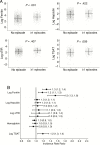Iron Status and Associated Malaria Risk Among African Children
- PMID: 30219845
- PMCID: PMC6522755
- DOI: 10.1093/cid/ciy791
Iron Status and Associated Malaria Risk Among African Children
Abstract
Background: It remains unclear whether improving iron status increases malaria risk, and few studies have looked at the effect of host iron status on subsequent malaria infection. We therefore aimed to determine whether a child's iron status influences their subsequent risk of malaria infection in sub-Saharan Africa.
Methods: We assayed iron and inflammatory biomarkers from community-based cohorts of 1309 Kenyan and 1374 Ugandan children aged 0-7 years and conducted prospective surveillance for episodes of malaria. Poisson regression models were fitted to determine the effect of iron status on the incidence rate ratio (IRR) of malaria using longitudinal data covering a period of 6 months. Models were adjusted for age, sex, parasitemia, inflammation, and study site.
Results: At baseline, the prevalence of iron deficiency (ID) was 36.9% and 34.6% in Kenyan and Ugandan children, respectively. ID anemia (IDA) affected 23.6% of Kenyan and 17.6% of Ugandan children. Malaria risk was lower in children with ID (IRR, 0.7; 95% confidence interval [CI], 0.6, 0.8; P < .001) and IDA (IRR, 0.7; 95% CI, 0.6, 0.9; P = .006). Low transferrin saturation (<10%) was similarly associated with lower malaria risk (IRR, 0.8; 95% CI, 0.6, 0.9; P = .016). However, variation in hepcidin, soluble transferrin receptors (sTfR), and hemoglobin/anemia was not associated with altered malaria risk.
Conclusions: ID appears to protect against malaria infection in African children when defined using ferritin and transferrin saturation, but not when defined by hepcidin, sTfR, or hemoglobin. Additional research is required to determine causality.
Clinical trials registration: ISRCTN32849447.
Keywords: African children; iron deficiency; iron status; malaria risk.
© The Author(s) 2018. Published by Oxford University Press for the Infectious Diseases Society of America.
Figures



References
-
- World Health Organization. World Malaria Report 2015. WHO: Geneva, Switzerland, 2015.
Publication types
MeSH terms
Substances
Associated data
Grants and funding
LinkOut - more resources
Full Text Sources
Other Literature Sources
Medical

